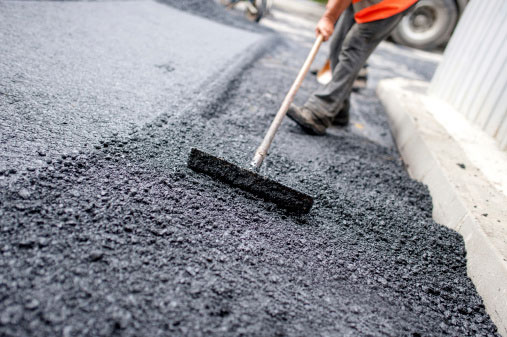Warm Mix Asphalt: A Lasting Service for Pavement
Hot Mix Asphalt (HMA) has emerged as a leading lasting option for sidewalk options, supplying a myriad of ingenious technologies and environmental benefits. Its capability to decrease and recycle materials energy consumption offers an engaging situation for its fostering in roadway building jobs. Furthermore, the long-term performance and sturdiness of HMA make it a favored option for framework growth. As the demand for eco-friendly building and construction methods grows, checking out the subtleties of HMA's sustainability can offer valuable understandings into the future of sidewalk remedies.
Ecological Benefits of Warm Mix Asphalt

In Addition, Hot Mix Asphalt aids to reduce city warmth island effects. Its dark shade absorbs sunlight, minimizing the quantity of warmth showed back right into the ambience contrasted to lighter-colored sidewalks. This can reduce ambient temperature levels in urban areas, decreasing the need for air conditioning and eventually lowering energy intake.
On top of that, Hot Mix Asphalt adds to enhanced stormwater administration. Its permeable nature permits water to charge and penetrate the sidewalk groundwater products, reducing runoff and the risk of flooding. These ecological advantages make Warm Mix Asphalt a lasting selection for leading freeways and roadways.
Energy Effectiveness in HMA Manufacturing
Is energy performance an important variable in the manufacturing of Hot Mix Asphalt (HMA)? Power plays a considerable role in the manufacturing of HMA, influencing both price and ecological sustainability. One essential facet of power effectiveness in HMA production is the usage of cozy mix asphalt (WMA) technologies.
In addition, improvements in plant innovations have led to even more energy-efficient HMA production procedures. Modern plants are designed with attributes like recycled asphalt sidewalk (RAP) processing abilities, efficient heater systems, and enhanced insulation, all adding to power cost savings. By maximizing energy use in HMA production, the sector can minimize its carbon impact while preserving high-quality sidewalk materials. Power efficiency is, as a result, an essential factor to consider in ensuring the sustainability of Warm Mix Asphalt production.
Recyclability of Warm Mix Asphalt
The recyclability of Hot Mix Asphalt (HMA) is an essential facet of its sustainability and long-term environmental impact. HMA is just one of one of the most recycled materials in the United States, with over 100 million lots of redeemed asphalt sidewalk (RAP) being recycled each year in new pavement building. Recycling HMA offers a number of ecological advantages, such as lowering the need for virgin materials, decreasing power intake throughout manufacturing, and decreasing the amount of waste sent out to land fills.
The procedure of reusing HMA entails crushing the existing pavement, crushing it into smaller pieces, and mixing it with brand-new aggregate and asphalt binder to develop a recycled mix. This recycled mix can often perform as well as and even better than traditional HMA, while requiring fewer basic materials and producing reduced greenhouse gas discharges. By including RAP right into new pavement projects, roadway firms can preserve all-natural resources, decrease costs, and minimize the ecological footprint of roadway building and Full Report construction and upkeep activities. Overall, the recyclability of HMA plays a significant duty in advertising sustainable practices within the pavement industry.

Long-Term Performance of HMA
Asphalt sidewalks demonstrate longevity and durability over an extensive period, mirroring the long-lasting efficiency of Hot Mix Asphalt (HMA) In addition, improvements in HMA technology, such as the use of polymer-modified binders and warm mix asphalt, have actually even more boosted the sturdiness and long life of HMA sidewalks. By prioritizing top quality construction and maintenance techniques, HMA proceeds to show itself as a economical and lasting service for resilient sidewalk infrastructure.

HMA: Longevity and Sustainability
Demonstrating both sturdiness and sustainability, Warm Mix Asphalt (HMA) has become a keystone in the construction of durable sidewalk facilities - angled parking. HMA's longevity comes from click to investigate its capacity to endure hefty lots, extreme climate condition, and high traffic volumes, making it a reliable option for roadways, freeways, and airport paths. The make-up of HMA, which usually consists of aggregates, binder, and filler, plays useful content a vital role in improving its long life and resistance to deterioration
In addition, HMA's sustainability lies in its recyclability and energy-efficient production procedure. The capability to reuse recovered asphalt sidewalk (RAP) in brand-new HMA mixtures reduces the demand for virgin products and decreases the ecological influence of pavement construction and upkeep. In addition, the power efficiency of creating HMA hinges on its reduced mixing temperature levels contrasted to various other pavement materials, resulting in decreased energy consumption and greenhouse gas exhausts.
Conclusion
In verdict, warm mix asphalt (HMA) provides a lasting option for pavement with its eco pleasant qualities. HMA's recyclability, power effectiveness in production, and lasting toughness make it an eco-friendly choice for roadway construction.
HMA is one of the most recycled products in the United States, with over 100 million heaps of reclaimed asphalt sidewalk (RAP) being reused each year in brand-new pavement building.The process of reusing HMA involves crushing the existing pavement, crushing it right into smaller items, and mixing it with brand-new aggregate and asphalt binder to develop a recycled mix.Asphalt pavements show longevity and strength over an extended duration, reflecting the lasting performance of Warm Mix Asphalt (HMA) Additionally, improvements in HMA technology, such as the use of polymer-modified binders and warm mix asphalt, have actually further improved the durability and durability of HMA sidewalks. The ability to recycle reclaimed asphalt sidewalk (RAP) in brand-new HMA mixes minimizes the need for virgin materials and lessens the ecological impact of sidewalk building and construction and maintenance.